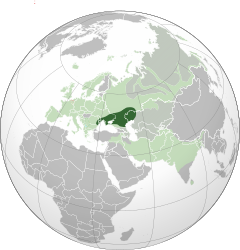
Back موطن اللغة الهندية الأوروبية البدائية Arabic Urheimat protoindoeuropeo Spanish خاستگاه نیاهندواروپاییان Persian Indoeurooppalaisten alkuperä Finnish Urheimat dos indoeuropeos Galician Հնդեվրոպական նախահայրենիք Armenian Tanah air Proto-Indo-Eropa ID Urheimat protoindoeuropea Italian Indoeuropiečių protėvynė Lithuanian Proto-Indo-Europees thuisland Dutch

| Part of a series on |
| Indo-European topics |
|---|
 |
The Proto-Indo-European homeland was the prehistoric linguistic homeland of the Proto-Indo-European language (PIE). From this region, its speakers migrated east and west, and went on to form the proto-communities of the different branches of the Indo-European language family.
The most widely accepted proposal about the location of the Proto-Indo-European homeland is the steppe hypothesis,[note 1] which puts the archaic, early, and late PIE homeland in the Pontic–Caspian steppe around 4000 BCE.[1][2][3][4][5] The leading competitor is the Anatolian hypothesis, which puts it in Anatolia around 8000 BCE.[1][6][7][8] A notable third possibility, which has gained renewed attention in the 2010s and 2020s due to aDNA research, is the Armenian hypothesis, which situates the homeland for archaic PIE south of the Caucasus.[9][10][11][12][13] Several other explanations have been proposed, including the outdated but historically prominent North European hypothesis, the Neolithic creolisation hypothesis, the Paleolithic continuity paradigm, the Arctic theory, and the "indigenous Aryans" (or "out of India") hypothesis. These are not widely accepted, and are considered to be fringe theories.[14][2][15]
The search for the homeland of the Indo-Europeans began in the late 18th century with the rediscovery of the Indo-European language family.[16] The methods used to establish the homeland have been drawn from the disciplines of historical linguistics, archaeology, physical anthropology and, more recently, human population genetics.
Cite error: There are <ref group=note> tags on this page, but the references will not show without a {{reflist|group=note}} template (see the help page).
- ^ a b Mallory & Adams 2006.
- ^ a b Anthony 2007.
- ^ Pereltsvaig & Lewis 2015, pp. 1–16.
- ^ Anthony & Ringe 2015.
- ^ Haak et al. 2015.
- ^ Renfrew, Colin (1990). Archaeology and Language: The Puzzle of Indo-European Origins. CUP Archive. ISBN 9780521386753.
- ^ Gray & Atkinson 2003.
- ^ Bouckaert et al. 2012.
- ^ Haak et al. 2015, p. 138, Supplementary Information.
- ^ Reich 2018, p. 177.
- ^ Damgaard 2018, p. 8.
- ^ Wang et al. 2018, p. 10.
- ^ Grolle 2018, p. 108.
- ^ Trautmann 2005, p. xiii.
- ^ Parpola 2015.
- ^ Pereltsvaig & Lewis 2015, pp. 19–38.